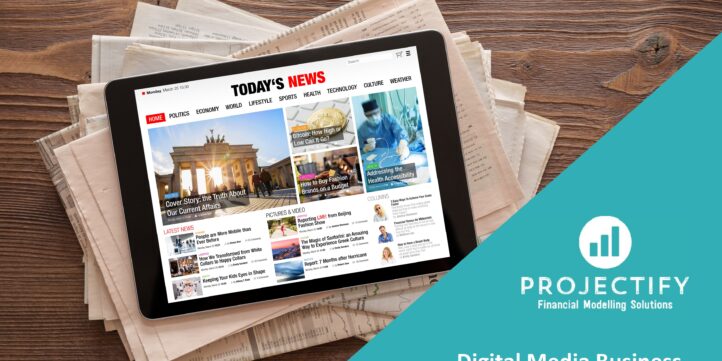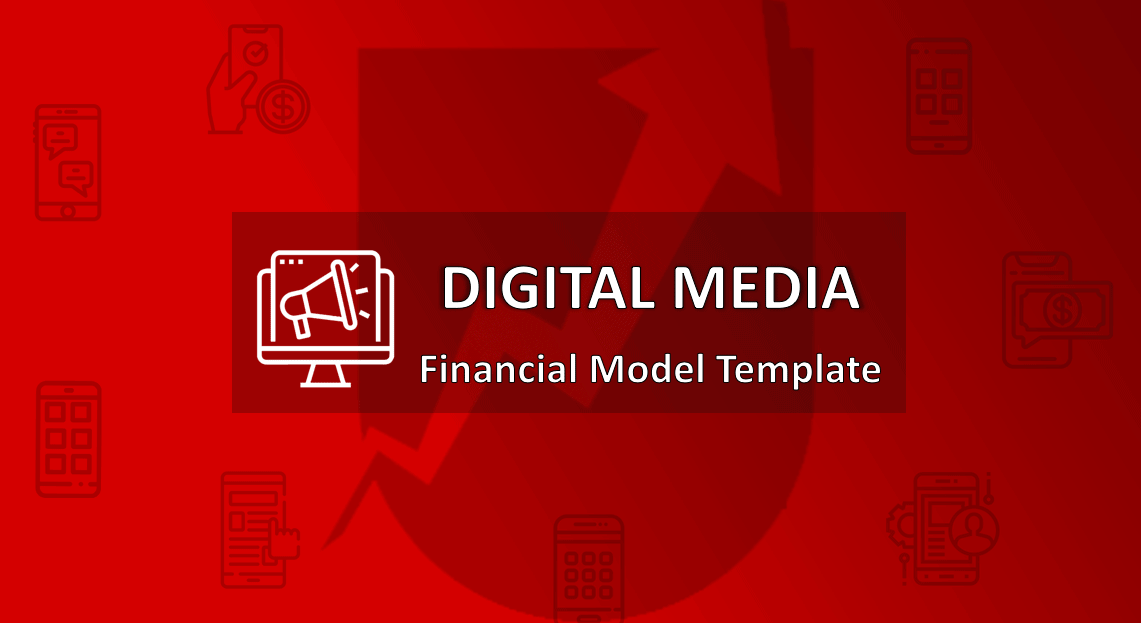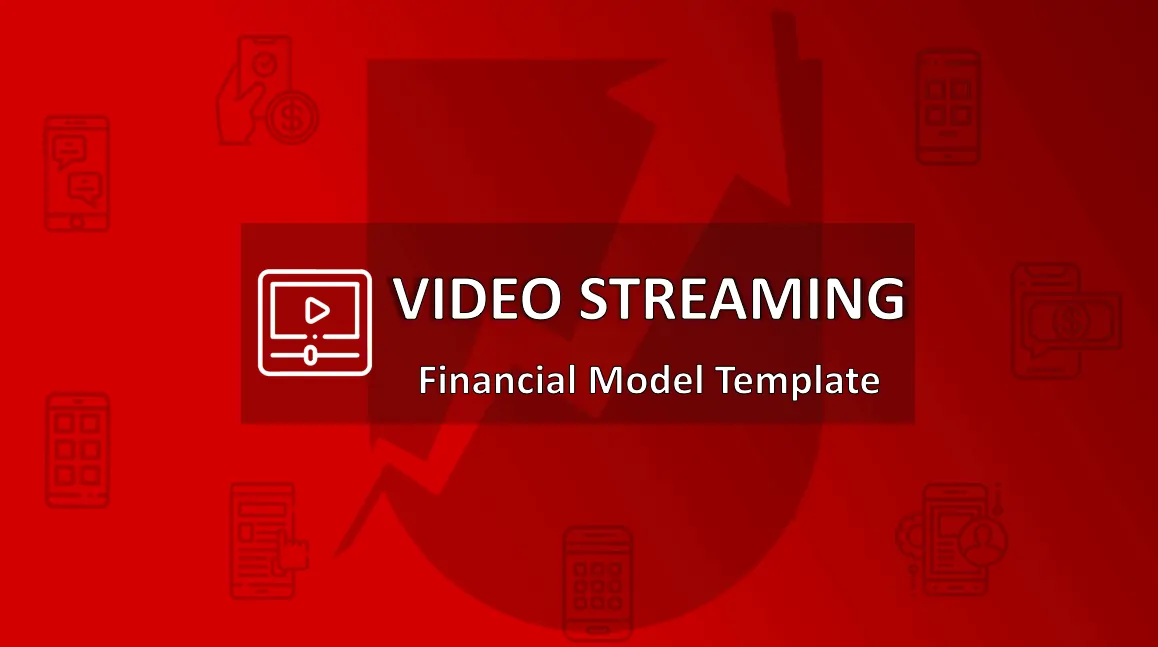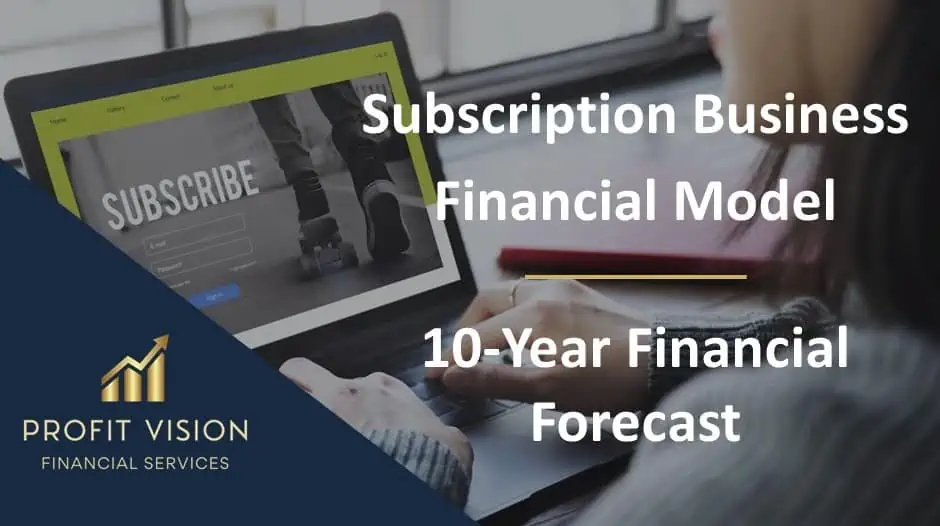Digital Media Business Financial Projection 3 Statement Model
3 statement 5 year rolling financial projection Excel model for a startup or existing digital media business generating revenue through subscription plans and advertising revenue

PURPOSE OF MODEL
Highly versatile and user-friendly Excel model for the preparation of a 5-year rolling 3 statement (Income Statement, Balance Sheet, and Cash flow Statement) financial projection with a monthly timeline for a startup or existing digital media business generating revenue by providing online content on a subscription basis and also through advertising.
The model allows the user to model up to 5 different subscription plans to view online content with monthly, quarterly, or annual subscription periods for each plan. The model also allows the user to model advertising revenue generated from both the number of impressions and clicks, as well as 5 additional categories for any other income. Apart from revenue, the model allows the user to model direct and non-direct staff costs, direct expenses, marketing costs, other administrative costs, fixed assets, deferred income, sales tax impacts, corporate tax borrowings, equity additions, and dividends distributions.
The model follows good practice financial modeling principles and includes instructions, line item explanations, checks, and input validations.
KEY OUTPUTS
The key outputs include:
– Projected full financial statements (Income Statement, Balance Sheet, and Cash flow Statement) presented on a quarterly basis across up to 5 years and summarised on an annual basis.
– Dashboard with:
o Summarised projected Income Statement and Balance Sheet;
o Compounded Annual Growth rate (CAGR) for each summarised income statement and Balance Sheet line item;
o List of key ratios including average revenue growth, average profit margins, average return on assets and equity, and average debt to equity ratio;
o Bar charts summarising income statement and Balance Sheet projections;
o Chart presenting revenue mix, total subscribers per month, and total website traffic.
KEY INPUTS
Inputs are split into Income Statement and Balance Sheet Inputs. Most inputs include user-friendly line item explanations and input validations to help users understand what the input is for and populate correctly.
Setup Inputs:
– Name of business;
– Currency;
– First projection year and quarter;
– Naming for subscription plans, other income categories, expense categories, fixed asset categories, and borrowings;
Actuals Inputs:
– Opening balance sheet (for existing businesses);
– Income Statement actuals (for trend analysis);
Projection Inputs:
– Subscription Revenue including new subscribers; free trial to paid user conversion rate; monthly, annual, quarterly subscription plan mix; renewal rates and subscription prices.
– Advertisement revenue including website traffic; average session duration; advert impressions per minute; click-through rate; rate per mille impressions and rate per click.
– Other income: volume of units and price per unit.
– Staff Costs including: staff numbers; average annual cost per staff member; average employer’s payroll taxes as % of salary; average annual bonus and average healthcare benefits per staff member;
– Other cost inputs including
o Direct expenses;
o Marketing costs;
o Staff costs;
o Other costs.
– Sales and corporate tax inputs including rate and payment periods;
– Dividend inputs including amount or percentage of retained earnings and frequency;
– Fixed Assets including additional amounts and useful life;
– Borrowings including addition/redemption amounts and interest rate;
– Share Capital additions.
MODEL STRUCTURE
The model comprises of 9 tabs split into input (‘i_’), calculation (‘c_’), output (‘o_’) and system tabs. The tabs to be populated by the user are the input tabs (‘i_Setup’, ‘i_Actuals’, and ‘i_Assumptions’). The calculation tab uses the user-defined inputs to calculate and produce the projection outputs which are presented in ‘o_Fin Stats’, ‘o_Dashboard’, and ‘o_DCF’.
KEY FEATURES
– The model follows best practice financial modeling guidelines and includes instructions, line item explanations, checks, and input validations;
– The model is not password protected and can be modified as required following download;
– The model contains a dynamic timeline that allows for a mix of actual and forecast periods across a 5-year period allowing projections to be rolled forward from month to month;
– Timeline is split on a monthly basis and summarised on an annual basis;
– The model allows the user to model up to 5 separate subscription plans and advert revenue based on impressions and clicks
– Apart from projecting revenue and costs the model includes the possibility to model deferred income, payables, fixed assets, borrowings, dividends, corporate tax, and sales tax;
– The model included an integrated discounted cash flow valuation using the projected cash flow outputs;
– The model includes instructions, line item explanations, checks, and input validations to help ensure input fields are populated accurately;
– The model includes a checks dashboard that summarises all the checks included in the various tabs making it easier to identify errors.
Similar Products
Other customers were also interested in...
Youtube Content Creator Financial Model Excel Temp...
The UPtick Youtube Content Creator Template is a simple yet robust financial model that allows you t... Read more
Digital Media Financial Model Excel Template (Full...
The UPtick Digital Media Template is a simple yet robust financial model that allows you to make int... Read more
Film Production 10-Year 3 Statement Financial Proj...
10 year rolling financial projection Excel model for a new or existing film production business with... Read more
Video Streaming Financial Model Excel Template (Fu...
Fully-Vetted Comprehensive Video Streaming Financial Model + Video Streaming Guide eBook + Youtube V... Read more
“Netflix for Gadgets” – Consumer-Tech Subscr...
An integrated, dynamic and ready-to-use financial model for Consumer-Tech Subscription/Rental Busine... Read more
Subscription Business – 10 Year Financial Model
Financial Model providing a 10-year financial plan for a startup or operating Subscription Business.... Read more
Traditional Advertising Agency Financial Model Exc...
Discover Traditional Advertising Agency Financial Projection Template. Allows you to start planning ... Read more
Direct Marketing Agency Financial Model Excel Temp...
Order Direct Marketing Agency Financial Model. Allows you to start planning with no fuss and maximum... Read more
Digital Marketing Agency Financial Model Excel Tem...
Check Our Digital Marketing Agency Financial Projection Template. Excel Template for your pitch deck... Read more
Social Media Agency Financial Model Excel Template
Check Social Media Agency Financial Model. Creates 5-year Pro-forma financial statements, and financ... Read more
Reviews
3 statement 5 year rolling financial projection Excel model is an incredible tool for a startup
360 of 696 people found this review helpful.
Help other customers find the most helpful reviews
Did you find this review helpful?
-
Hi Luis, thank you very much for your review
Thank you for your feedback.
345 of 694 people found this review helpful.
You must log in to submit a review.




















